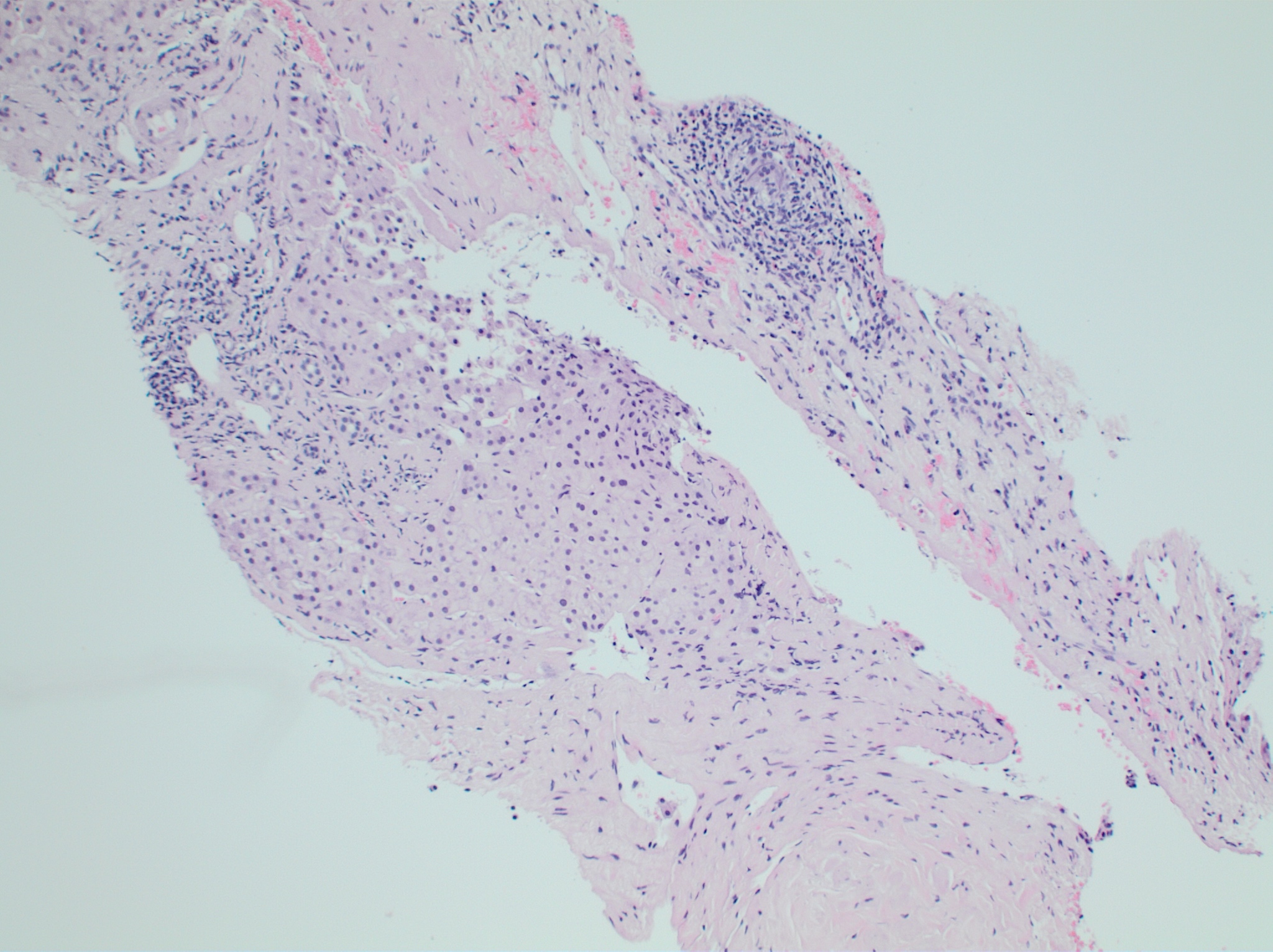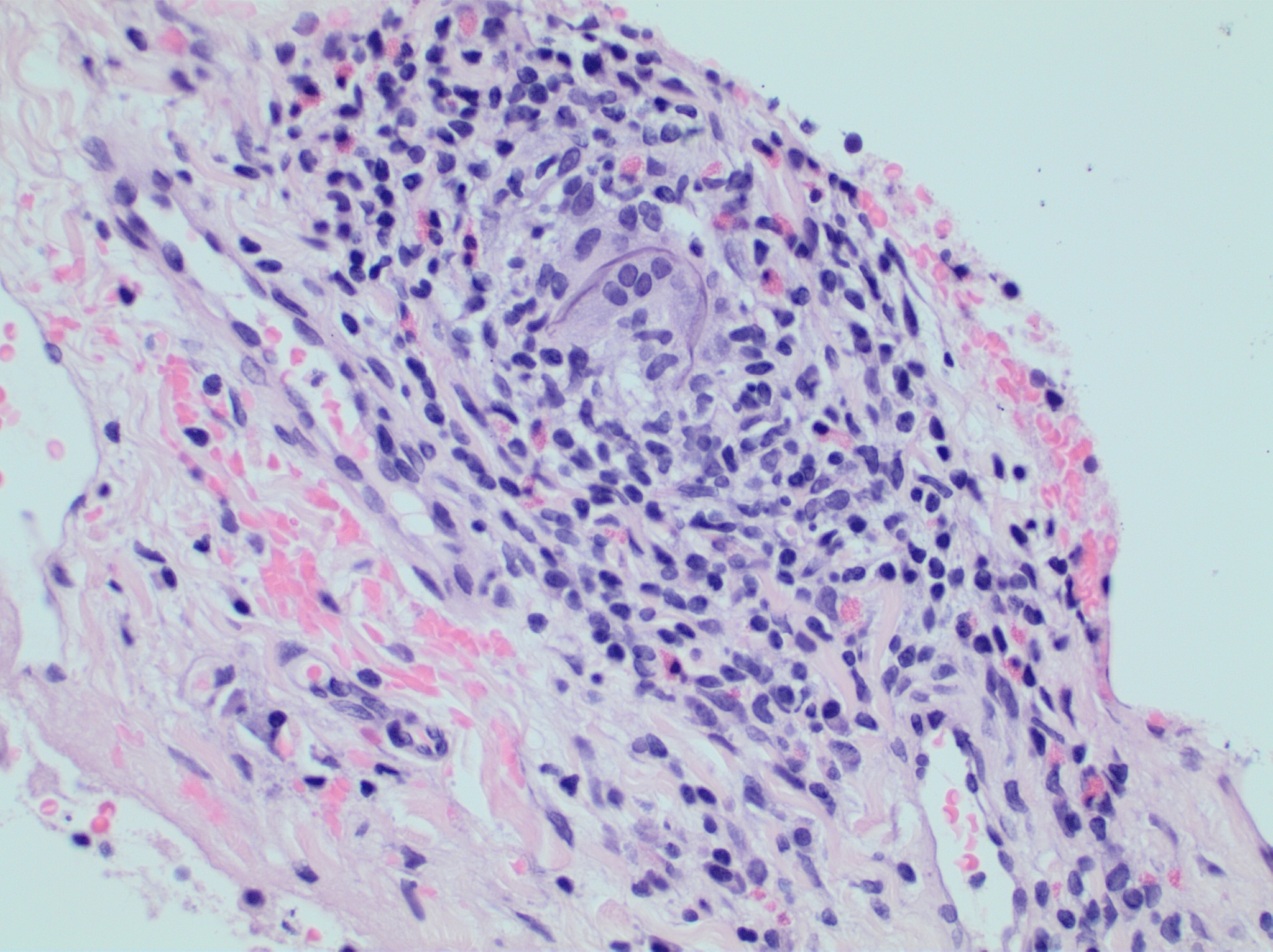Monday Poster Session
Category: Liver
P3893 - A Case of Snail Fever-Induced Cirrhosis
Monday, October 27, 2025
10:30 AM - 4:00 PM PDT
Location: Exhibit Hall

Karol Suchowiecki, MD
University of Connecticut Health Center
Farmington, CT
Presenting Author(s)
Karol Suchowiecki, MD1, Sharon J. Dellinger, APRN2, Neil Parikh, MD3
1University of Connecticut Health Center, Farmington, CT; 2Connecticut GI, New Britain, CT; 3Connecticut GI, Farmington, CT
Introduction: Snail fever, formally known as Schistosomiasis, though common worldwide, is a rare cause of liver cirrhosis in the U.S. We present a case of liver cirrhosis induced by chronic schistosomiasis infection.
Case Description/
Methods: A 35-year-old male with hyperlipidemia, remote schistosomiasis as a child, and no known prior history of liver disease was referred to GI for chronically elevated liver enzymes (AST 76, ALT 99, ALP 387, GGT 442) and heterogeneous, echogenic liver noted on ultrasound. He reported mild intermittent left upper quadrant discomfort and denied alcohol use. An initial non-invasive liver workup was negative for viral hepatitis, autoimmune hepatitis, primary biliary cirrhosis, lupus, hemochromatosis, Wilson’s disease, and alpha 1 antitrypsin deficiency. A Fibroscan found A3 inflammation and F4 fibrosis. MRCP demonstrated diffusely heterogeneous liver parenchyma with microlobulation and splenomegaly, consistent with cirrhosis and portal hypertension. Liver biopsy confirmed cirrhotic liver with schistosoma eggs surrounded by granulomatous inflammation in the fibrotic portal area. Advanced bridging fibrosis was seen with trichrome and reticulin stains. Endoscopy found grade II esophageal varices. During a subsequent visit, the patient recalled a diagnosis of “bilharziasis” at age 9 in Yemen associated with passing worms in his stool for which he was treated with an herbal remedy at the time, however never received praziquantel. He was started on praziquantel, and a non-selective beta blocker, and is currently undergoing evaluation for liver transplant.
Discussion: Schistosomiasis is one of the most common parasitic infections and causes of portal hypertension worldwide. Though quite rare in the U.S., it should be considered in the differential diagnosis of chronic liver disease, particularly among immigrants from endemic regions. Hepatosplenic schistosomiasis typically causes periportal fibrosis with minimal hepatocellular damage. However, in this case, the patient exhibited advanced bridging fibrosis and the classical sequelae of portal hypertension. No other underlying cause of cirrhosis was identified, making chronic schistosomiasis the most likely etiology.

Figure: Figure 1: Schistosoma Egg Low Power (Hematoxylin and Eosin)

Figure: Figure 2: Schistosoma Egg High Power (Hematoxylin and Eosin)
Disclosures:
Karol Suchowiecki indicated no relevant financial relationships.
Sharon Dellinger indicated no relevant financial relationships.
Neil Parikh indicated no relevant financial relationships.
Karol Suchowiecki, MD1, Sharon J. Dellinger, APRN2, Neil Parikh, MD3. P3893 - A Case of Snail Fever-Induced Cirrhosis, ACG 2025 Annual Scientific Meeting Abstracts. Phoenix, AZ: American College of Gastroenterology.
1University of Connecticut Health Center, Farmington, CT; 2Connecticut GI, New Britain, CT; 3Connecticut GI, Farmington, CT
Introduction: Snail fever, formally known as Schistosomiasis, though common worldwide, is a rare cause of liver cirrhosis in the U.S. We present a case of liver cirrhosis induced by chronic schistosomiasis infection.
Case Description/
Methods: A 35-year-old male with hyperlipidemia, remote schistosomiasis as a child, and no known prior history of liver disease was referred to GI for chronically elevated liver enzymes (AST 76, ALT 99, ALP 387, GGT 442) and heterogeneous, echogenic liver noted on ultrasound. He reported mild intermittent left upper quadrant discomfort and denied alcohol use. An initial non-invasive liver workup was negative for viral hepatitis, autoimmune hepatitis, primary biliary cirrhosis, lupus, hemochromatosis, Wilson’s disease, and alpha 1 antitrypsin deficiency. A Fibroscan found A3 inflammation and F4 fibrosis. MRCP demonstrated diffusely heterogeneous liver parenchyma with microlobulation and splenomegaly, consistent with cirrhosis and portal hypertension. Liver biopsy confirmed cirrhotic liver with schistosoma eggs surrounded by granulomatous inflammation in the fibrotic portal area. Advanced bridging fibrosis was seen with trichrome and reticulin stains. Endoscopy found grade II esophageal varices. During a subsequent visit, the patient recalled a diagnosis of “bilharziasis” at age 9 in Yemen associated with passing worms in his stool for which he was treated with an herbal remedy at the time, however never received praziquantel. He was started on praziquantel, and a non-selective beta blocker, and is currently undergoing evaluation for liver transplant.
Discussion: Schistosomiasis is one of the most common parasitic infections and causes of portal hypertension worldwide. Though quite rare in the U.S., it should be considered in the differential diagnosis of chronic liver disease, particularly among immigrants from endemic regions. Hepatosplenic schistosomiasis typically causes periportal fibrosis with minimal hepatocellular damage. However, in this case, the patient exhibited advanced bridging fibrosis and the classical sequelae of portal hypertension. No other underlying cause of cirrhosis was identified, making chronic schistosomiasis the most likely etiology.

Figure: Figure 1: Schistosoma Egg Low Power (Hematoxylin and Eosin)

Figure: Figure 2: Schistosoma Egg High Power (Hematoxylin and Eosin)
Disclosures:
Karol Suchowiecki indicated no relevant financial relationships.
Sharon Dellinger indicated no relevant financial relationships.
Neil Parikh indicated no relevant financial relationships.
Karol Suchowiecki, MD1, Sharon J. Dellinger, APRN2, Neil Parikh, MD3. P3893 - A Case of Snail Fever-Induced Cirrhosis, ACG 2025 Annual Scientific Meeting Abstracts. Phoenix, AZ: American College of Gastroenterology.
